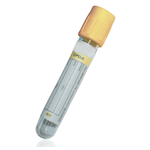Suitable Specimen Types
- Serum
- EDTA Plasma
- Li Hep Plasma
Sample Processing in Laboratory
UsualSample Preparation
Samples are batched for analysis twice a week. Samples may be stored at 4 °C for 14 days without significant decrease.Turnaround Time
1 weekSample Stability
Samples are batched for analysis twice a week. Samples may be stored at 4 °C for 14 days without significant decrease.Lipoprotein a (Lp (a))
General Information
Lipoprotein (a) [Lp(a)] is made in the liver and then enters the bloodstream. Elevated plasma concentrations of Lp(a) are a risk factor for coronary heart disease, cerebrovascular disease, atherosclerosis, thrombosis and stroke. High Lp(a) levels increases the risk of plaque thrombosis possibly by the following mechanism. Lp(a) accumulates in the vessel wall and inhibits binding of plasminogen to the cell surface which increases clotting by reducing plasmin. Inhibition of plasminogen also promotes proliferation of smooth muscle cells. Lp(a) concentrations may be affected by disease state. Niacin and aspirin are known to reduce levels of Lp(a) in some individuals.
Lp(a) is composed of two polypeptide components Apolipoprotein (a) [apo(a)] and a LDL-like protein containing Apolipoprotein B-100. These are connected via a disulfide bond. The interindividual variation in Lp(a) levels is 90% genetically determined by the LPA locus, a large gene found on chromosome 6. Apo(a) is a large protein encoded by LPA and is composed of a signal peptide region, many repeating kringle domains and a protease domain.
Measurement of Lp(a) levels is still relatively new though assays have been available for a number of years. This is mainly because of differences in assay and a lack of understanding of the clinical relevance of results. There has been recent interest in Lp(a), however levels should only be interpreted other lipid tests and clinical evaluation. It has been reported that elevated levels have been seen in nephritic syndrome, patients undergoing renal disease, patients with uncontrolled diabetes mellitus and hyopthyroidism.
Patient Preparation
None
Notes
Serum from standard sampling tubes and plasma from Li heparin, Na heparin, Na EDTA, K EDTA are acceptable.
Reference Range
Increased coronary risk over 75 nmol/L.
Specifications
- EQA Scheme?: Yes
- EQA Status: UK NEQAS Lipids
